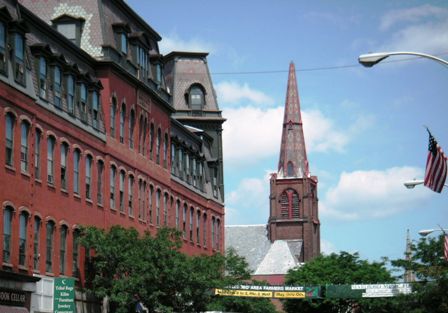|
the judiciary (ch 13)
Reread Article III of the US Constitution
Summons: http://www.supremecourtus.gov/index.html
Points to ponder:
1. The case of Marbury v Madison (1803) is vital to an appreciation of the development of the judiciary in the US political system
2. The federal courts in the US have two severe institutional problems
- unlike members of Congress and the president, federal judges are not elected and so don’t have a “mandate” that will legitimize, or make legitimate, their decisions (most--but not all--states judges are popularly elected [A. Liptak, "Rendering justice" NYT 25 May 08]); indeed, throughout the 1990s the US courts were about as likely to be regarded unfavorably as favorably, probably because of a perceived leniency towards criminals and doubts about equal justice (Americans only a little better off, but much less anxious), but it should be noted that the US Supreme Court met with levels of approval 20 points higher; on the other hand, a new survey shows a marked decine in the public's view of the Supreme Court (A. Liptak & A. Kopicki, "Approval rating for justices" NYT 7 Jun 12)
- the second problem for courts is that they can issue rulings and orders but cannot implement them, depending on the other branches of government to take action to make judicial decisions effective; although the Supreme Court ordered desegregation of public schools with “all due deliberate speed” in 1954, it was still issuing desegregation orders in the 1970s because of the failure of school districts to comply; for another example, after the Supreme Court ruled in 1963 that school prayer is “in direct violation of constitutional rights” (Abington v Schempp), the teacher-reported incidence of public school prayer dropped from 60% in 1962 to 28% in 1964-65, a change that might look impressive except that more than one-quarter of teachers still reported being out of compliance (rumors persist that public school prayer still goes on)
3. Lacking a mandate and depending on others to implement its decisions, courts try to avoid appearing to be political institutions, but courts are inevitably political
- recall the hot button issues decided by the courts—death penalty, medical use of marijuana, prayer in school, detention of suspected terrorists and non-state combatants after the September 2001 attacks, abortion, same-sex marriage, flag burning, the phrase “under God” in the Pledge of Allegiance, protections for those arrested and prosecuted for criminal offences, and many more
- not all Supreme Court cases are as provocative as these, as is suggested by a nice Linda Greenhouse piece
("Devil in the details" NYT 28 May 07)
- on the other hand, what seems like a small change, making it easier to disqualify those "soft" on the death penalty from capital cases, may have significant effects on criminal law, as Adam Liptak reports ("Ruling likely to spur" NYT 9 Jun 07)
- somewhere in the middle, perhaps, is the suit by Alaskan fisherman and other residents against Exxon in connection with a 1989 oil spill; the PBS Newshour carried a report on oral arguments before the Supreme Court in February 2008 when Exxon sought to have a $2.5 billion award set aside (the Court handed down it's decision on 25 June 2008 as A. Liptak reports in "Damages cut" NYT 26 Jun 08); to give an another middling example, the Supreme Court ruled on the question of whether public school districts have to pay for the private school tuitions of students needing special education services (T. Lewin, "Supreme Court to address" NYT 30 May 09) that the district is thought, rightly or wrongly, to be unable to provide (yes, as it turns out)
- witness all the political conflict over judicial nominations--consider President Bush's nominations of Pickering for the Court of Appeals and Meirs for the Supreme Court, threats in the 2004 by Republicans to use the "nuclear option" against potential filibusters by Democrats of Bush appointees, and the 2009 struggle over Obama's nomination of Sotomayor for the Supreme Court--and note that over 90% of judicial nominees just happen to be of the same party as the president who names them
- there is evidence that judges are themselves aware of the political environment in which they operate and the public response to their decisions, as is delightfully illustrated in the “switch in time that saved nine”
4. In line with the remark that “judges find the law, they do not make it” (the "legal model," 485-88) a number of legal principles--which are important in their own right and ought not to be totally discounted--are often invoked to soften the political appearance of courts
- stare decisis (translated as “let it stand”) or precedent: the idea that courts should be bound to rule as they have in the past; but there are plenty of instances in which precedents fall--Brown v Board of Education of Topeka (1954), which declared segregation of public schools unconstitutional overturned the precedent of Plessy v Ferguson (1892) which said that public institutions might maintain separate facilities for whites and blacks so long as they were equal (making clear the intention to overturn the Plessy precedent, Chief Justice Warren wrote in Brown, “We conclude that, in the field of public education, the doctrine of "separate but equal" has no place. Separate educational facilities are inherently unequal”); for another example, when the Supreme Court found a Texas sodomy conviction of two men to be unconstitutional in 2003, the Court overturned a precedent it had established just 17 years earlier
- neutral principles: courts should hold to legal principles without consideration to the particulars of the current case or the implications of its decisions for individuals or policies
- judicial restraint: courts should defer whenever possible to the other branches of government and, when they do intervene, should leave detailing the remedies to others as much as possible
5. In observing Supreme Court decisionmaking, one needs to distinguish the “vote” and the “opinion”
- in the case of X v Y, the vote tells how many rule in favor of X and how many in favor of Y, and this is really only of concern to X and Y because they are directly impacted, directly win or lose, as a result of the Court vote (in the medical marijuana case, Gonzales v Raich [2005], in which the vote was 6-3, the only people concerned with the vote are Gonzales, whose side got six votes, and unhappy Raich, whose side got three votes)
- the opinions are the writings of legal reasoning given by justices, explaining why they voted as they did, and these opinions are used by others in the political system (legislators, presidents and other executives, judges, lawyers, and, for that matter, interest groups and political parties and all the other players) to understand what the judges say the “law” requires or permits; only if five or more justices on the Supreme Court (an absolute majority) agree to sign on to a single opinion does the Court clearly establish what, at least for the moment, the law is (an example of a case where the absence of a five-justice majority leaves the law unsettled is the affirmative action case of Bakke); some of the most interesting politics in our political system involve the bargaining among the justices on the drafting of opinions so as to build a coalition of five or more joining together to issue a majority opinion;
6. The strategic model (487 ff) can be thought of more broadly than just having to do with the political sensitivity of judges in making decisions, the degree to which take into account political forces in making their decisions; in addition, there is plenty of evidence that judges act strategically to achieve their objectives
- there are reports that when President Nixon said he might disobsey a Supreme Court ruling ordering him to turn over his tape recordings in the Watergage case if the decision was not unanimous, justices rallied to decide the case unanimously
- recalling that ithe Chief Justice assigns the job of writing an opinion when he is in the majority, (479) there were claims that former Chief Warren Burger would switch his vote or hide his preference so as to control who would write the opinion so as to influence what the opinion would say
- ask me no questions, I'll tell you no lies: there was an interesting news article (A. Liptak, "When the justices ask questions" 25 May 09) in the Times on some research that suggests that the number of questions, in particular the number of challenging questions, posed by Supreme Court justices to lawyers at hearings helps predict how the Court will decide and that the questions justices pose are used to sway their colleagues
Questions to consider:
1. In general terms, how do the first three articles of the Constitution differ from each other? In particular, how does Article III compare as a whole with the legislative and executive articles?
2. Architecture as political symbolism. Ever been in a courtroom? Ever seen Law and Order? How might the design of courthouses and courtrooms be intended to achieve a certain political effect? How do other aspects of court—dress, language, ritual—contribute to this effect?
3. What is judicial review? How did the courts come to have the power of judicial review? How would US government be different if the courts did not have this power?
4. Think about this: Between 1803 and 1978, congressional acts were declared unconstitutional only 105 times, that’s 105 times out of more than 60,000 laws passed in that time, so a rate of 0.175%. (On the other hand. an average of nearly 20 state and local laws are declared unconstitutional each year). In other words, the Supreme Court wields its power to strike down laws passed by the US Congress only infrequently (just as presidents use their veto rarely). Why?
5. On Sonia Sotomayor's confirmation, there are are now six Catholic members of the the Court (and the other three are Jewish). Focusing on the Catholics, what would the attitudinal model (486-87) predict to be the implications of this for abortion and other cases involving religion? (Consider Linda Goodstein's report, "Sotomayor would be sixth" NYT 30 May 09.) Sotomayor is also the first Latina. What effect might that have on her decisions? On those of her colleagues? (See Liptak's report ["The waves" NYT 30 May 09] on this.)
6. What was the Korematsu case (1944). Of what possible relevance is it today?
.
|

